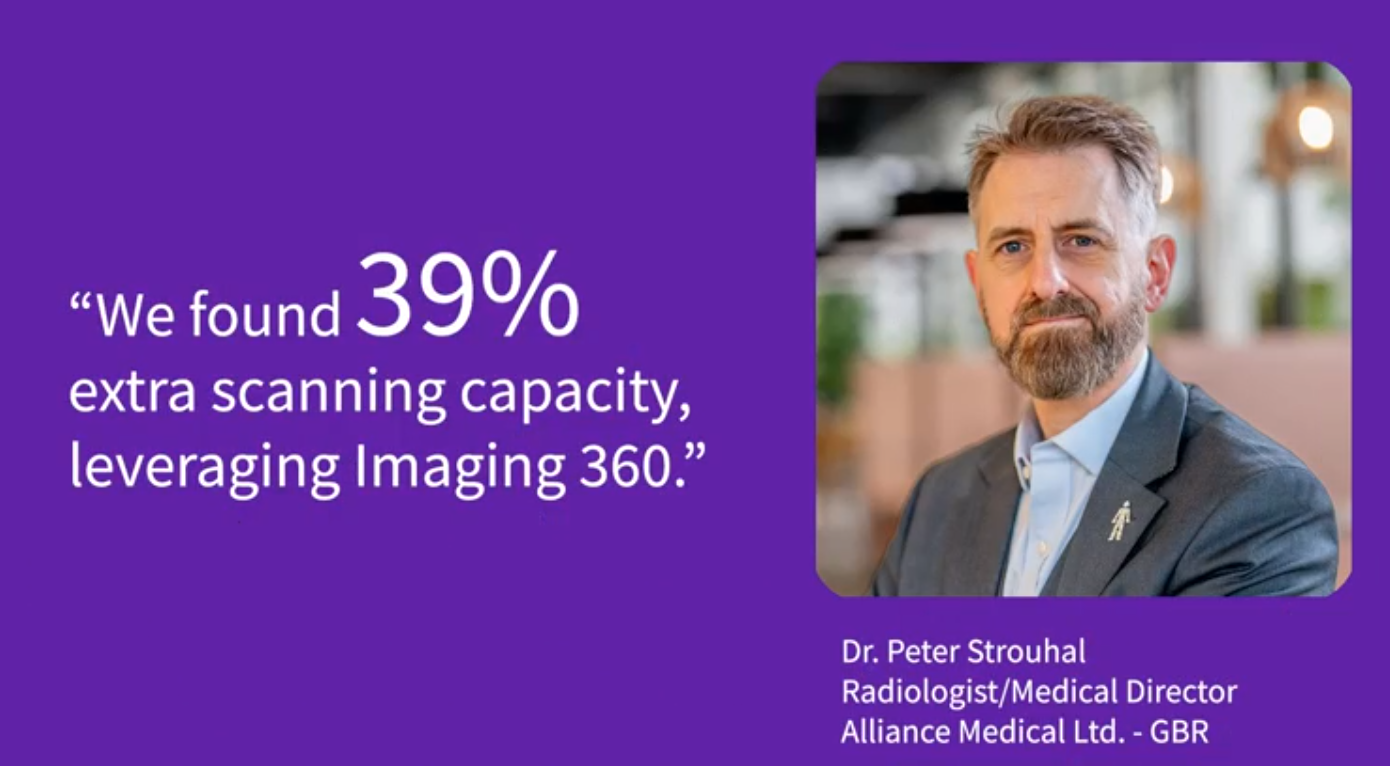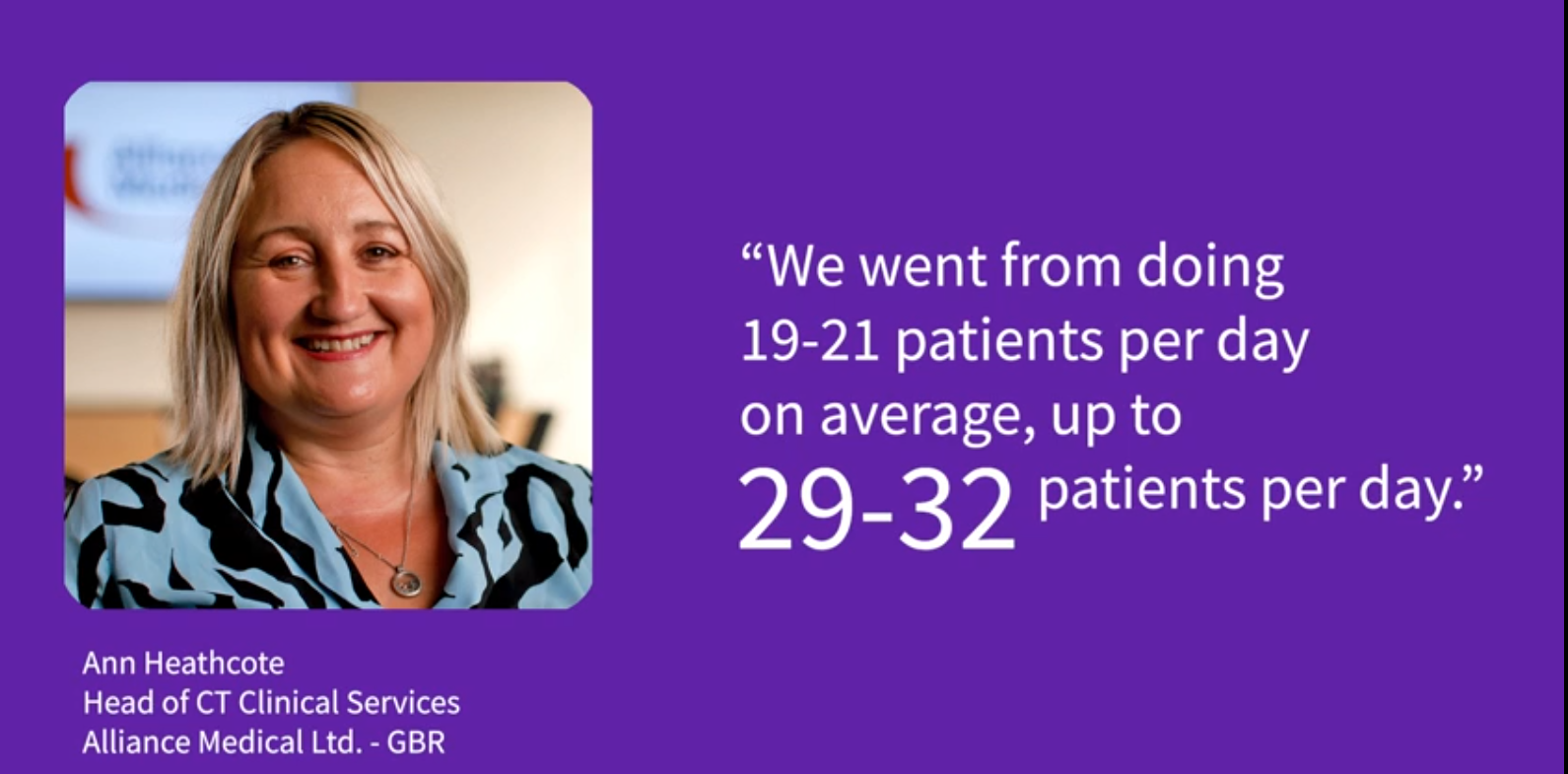The healthcare landscape has rapidly evolved in recent years, driven by advancements in digital technologies and an emphasis on patient-centered care. The demand for medical imaging, as a crucial component of that care, is rising at a faster rate than many other aspects of healthcare.[1] As a result, radiology administrators face immense pressure to maintain imaging quality across healthcare systems and manage radiology departments with a renewed focus on driving operational efficiencies and improved productivity to meet the growing demand for imaging services, often with an overburdened staff.
Helping to address radiology department challenges
Advanced digital solutions and AI tools designed for radiology operations offer radiology administrators and staff a holistic approach to managing operations, with insights for optimizing resource allocation and utilization, as well as standardizing performance and enhancing imaging efficiency across locations. Industry partners such as GE HealthCare understand these challenges and are creating digital solutions to enhance operational efficiencies in radiology and maximize resource optimization.
“GE HealthCare will continue to deliver digital solutions that can genuinely impact radiology departments’ ability to drive operational efficiencies that can help customers to deliver high-quality and consistent imaging to support growing exam volumes without overburdening their staff,” said Rekha Ranganathan, senior vice president, general manager, Imaging Platforms and Digital Solutions at GE HealthCare. “The Imaging 360 platform is a comprehensive digital ecosystem designed to unify radiology operations. It offers a bird’s eye view of radiology operations, which is crucial when large health systems offer imaging services in many locations. Imaging 360 offers analytical tools and AI solutions to help customers then identify pain points, address red flags, streamline operations without compromising on imaging quality or the patients’ experience, while enhancing the overall staff experience.”
Alliance Medical, a leading provider of diagnostic imaging services in the UK, exemplifies how adopting digital solutions can optimize radiology operations, enhance patient care, and boost efficiency across the board. In partnering with GE HealthCare, Alliance Medical has embarked on a journey to streamline its imaging services by leveraging the Imaging 360 platform. This partnership demonstrates how advanced digital solutions can meet the dynamic needs of radiology departments, ensuring high-quality care delivery while improving operational workflows.
Streamlining radiology operations with actionable insights across locations
As a leading provider of medical imaging services in the UK and across Europe, Alliance Medical manages over 600 static sites and operates 80 mobile scanners across eleven European countries. Managing this extensive infrastructure requires a robust, scalable digital solution to maximize operational efficiencies, and optimize resources. The UK branch of Alliance Medical employs around 1,200 staff and operates more than 150 sites in the UK.
“As a service provider, we’re widespread across the whole of England,” said Peter Strouhal M.D., Radiologist and Medical Director of Alliance Medical UK, “primarily doing imaging and expanding into community diagnostic centers. We’re bringing some of the imaging and potentially other diagnostic tests into the community where they are more accessible to the patient. One of the key advantages that we have as a private organization, however, is that we have a national view, and we manage and plan all of our business in that way, with a business intelligence server that provides us data and the operative information underneath it. And because we’re run truly like a business, you need to have that analytics layer.”
GE HealthCare’s Imaging 360 platform offers a suite of tools that provide real-time monitoring and performance analytics, helping Alliance Medical address challenges within its radiology operation, such as optimizing scheduling and throughput, addressing missed appointments, and facilitating protocol standardization and management across their many service locations.
Enhancing imaging resource allocation with optimized scheduling insights
Alliance Medical UK, like many imaging providers, wanted to achieve higher patient throughput given the increasing demand for imaging exams, but they did not want to overburden radiology staff or make patients feel rushed.
Ultimately, the question boils down to this. “How do we find time to scan more patients in a day?” said Strouhal. A holistic approach to data analysis offered Alliance Medical UK actionable insights to streamline exam scheduling with productivity analysis, equipment status dashboards, utilization analytics, and AI tools.
Using detailed data on scanning sequences and times, the staff were able to identify ways to standardize and shorten exams or to create exam blocks for certain types of scans, such as knee scans. Early on, Ann Heathcote, head of CT Clinical Services at Alliance Medical UK, noted the potential to book additional patients by reducing some scan times. At one site, a reduction in scan time from 30 minutes on average to 20 minutes had the potential to increase patient appointments by 35 per week, equivalent to more than one full extra day of scanning.
“We have to move away from [booking] one-half hour for all exams,” explained Strouhal. “By simply matching the appropriate schedule time to the scan type, we’ve realized a 39 percent increase in exam capacity.”
As a result, Alliance Medical UK is scanning more patients, and patients are waiting less time for their exams. With its data-driven approach, Imaging 360 helps Alliance Medical streamline scheduling and resource allocation. This ensures that each scanner is utilized to its full potential, avoiding bottlenecks and improving the overall patient experience.
“We’ve gone from scanning 19-21 patients per day on one scanner to 29-32 patients per day,” said Heathcote. “We’ve been able to streamline the service and suddenly find all those extra appointments. And we’re still only scanning 8 am to 8 pm.”
Predicting missed appointments using AI analytics
Traditional data analysis reviews data retrospectively. In terms of missed imaging exam appointments, the daily exam schedule can be significantly disrupted when patients don’t come in for their exams.
“And there wasn’t a lot we could do,” explained Strouhal. “There’s no option to manage the diary going forward because you’re looking backward. You could look back, and there wasn’t a pattern we could necessarily see. The difference with Imaging 360 being plugged into our data is that it looks at that retrospective diary, but it takes into account all other factors, and it could start to say, ‘Okay, most days you have two or three patients that don’t turn up.’ Or it can say it’s likely your 10:00 am appointment tomorrow will be late. We can proactively call patients to confirm their appointments and make adjustments when we need to. We can start to predict what’s happening tomorrow or what’s happening next week.”
Using AI and data analytics, Alliance Medical UK improved its understanding of missed appointments and identified ways to better manage scanner capacity, staffing, and scheduling efficiency.
Standardizing imaging protocols across the network
For a radiology operation as large as Alliance Medical UK, it is essential that imaging services be delivered consistently across the network where every patient receives high-quality imaging services and patient care.
“There are always local responsibilities,” Heathcote explained regarding their four static CT departments and 20 mobile units, “but for the overarching governance in a disparate organization such as ours, we need to have the assurance that everything is aligned for consistency across our fleet.”
Before using Imaging 360’s protocol management tool, it was difficult to manage protocols across locations and even more challenging to manually update them on each system. Using the operations platform, Alliance Medical UK was able to analyze the databases of CT units, which revealed that of the 47 standard protocols, all but 15 had deviations in some form. Alliance Medical UK used the analysis to create a standard library and can easily push out any updates or changes. The team can push out site-specific protocols for mobile scanners, whose protocols can differ by location.
Uniting radiology operations for improved performance
With the help of innovative digital solutions such as GE HealthCare’s Imaging 360, improving efficiencies in radiology operations is within reach and can have a significant impact as radiology departments struggle to meet the increasing demand for imaging services.
“We weren’t able to leverage the power of our network before using Imaging 360,” noted Strouhal. “The benefits are obvious. We have the data to turn into real outcomes.”
RELATED CONTENT:
- Hear more about how Imaging 360 impacted radiology operations for Alliance Medical, UK.
- Learn more about Imaging 360
DISCLAIMER
The results achieved by this facility may not be applicable to all institutions, and individual results may vary. This is provided for informational purposes only and its content does not constitute a representation or guarantee from GE HealthCare.
Not all products or features are available in all geographies. Check with your local GE HealthCare representative for availability in your country.



